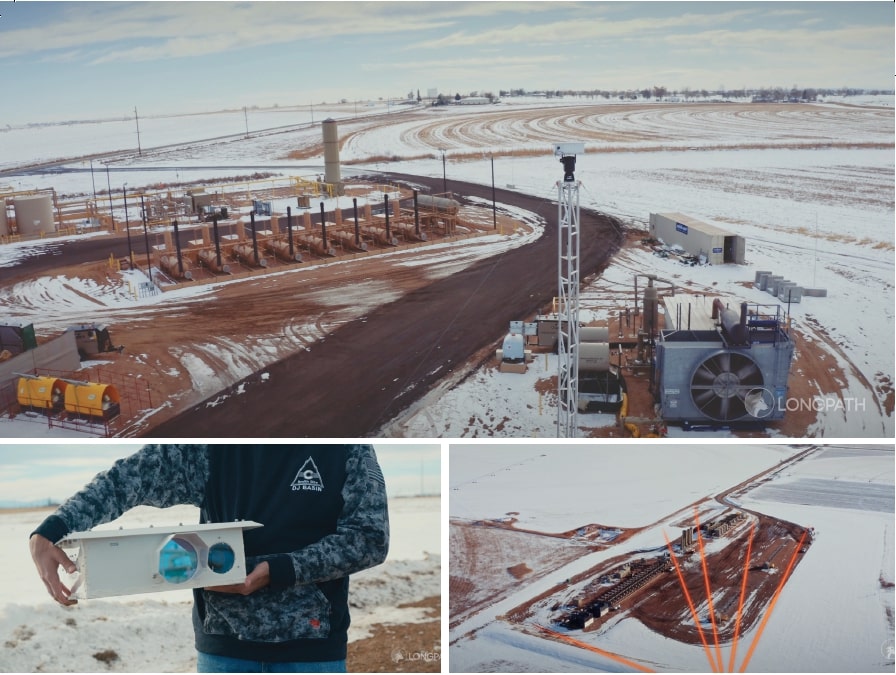Concerns about methane emissions are not new to the oil and gas industry, but a change in the U.S. Environmental Protection Agency’s (EPA) Methane Emissions Reduction Program has companies making adjustments to how they manage them.
Methane is the main component of natural gas. Colorless and odorless, methane is a contributor to global warming and is a known precursor gas to ground-level ozone, which can be harmful to humans in high concentrations. When leaked into the atmosphere, methane causes environmental damage. It also can damage a company’s bottom line by cutting into potential profit from natural gas sales and introducing costs from fines associated with the methane tax recently put in place.
The EPA has set standards to lower emissions from high-emitting equipment, mandated monitoring of methane leaks from well sites and compressor stations and directed companies to eliminate routine flaring of natural gas produced by new oil wells. New regulations also require companies to switch to zero-emitting technologies and discontinue the use of natural gas-powered pneumatic controllers.
The methane tax requires oil and gas facilities that emit more than 25,000 metric tons (mt) of CO2e per year to pay hundreds of dollars for each metric ton of methane released into the atmosphere. The tax took effect in 2024, with first payments due on March 31, 2025. Companies will pay $900/mt for reported methane emissions in 2024. The tax increases to $1,200/mt in 2025 and to $1,500/mt from 2026 onward.
Faced with progressively stringent requirements, companies are seeking technologies that make compliance easier. LongPath Technologies is one of the industry players providing solutions.
Breaking new ground
Methane monitoring in the oil and gas sector typically is conducted with aerial imaging or by using optical gas imaging cameras. LongPath’s technology continuously identifies and quantifies methane emissions at lower detection levels than conventional methods, according to the U.S. Department of Energy’s (DOE) Loan Programs Office (LPO).
Unlike traditional monitoring methods, the technology uses lasers to accurately identify molecules in the air and then alerts operators to leaks as small as 0.06 kg/hr. It was developed with the University of Colorado and the National Institutes of Standards and Technology, supported by the DOE’s Advanced Research Projects Agency–Energy and other DOE grants.
According to Greg Rieker, co-founder and CTO at LongPath, the technology works in much the same way as a cell phone network. “You subscribe to the cell phone network and then you get the data,” he said. “That’s exactly how LongPath works. We put out the nodes, we monitor the surrounding area, and then we feed that data back to the customers in real time so that if something happens, they’re aware of it very quickly.”
The Colorado-based company’s network includes 50 ft-to-70-ft-tall towers, which the company maintains and monitors. Each tower is equipped with transceivers that send out laser beams traveling up to a mile and a half. Covering about 10 sq miles, each node is capable of monitoring greenhouse gas emissions for dozens of facilities, such as production and compression facilities, delivering data in real time via dashboards and customized alerts to field personnel.

Growing the network
LongPath has networks in the Permian, Denver-Julesburg, Piceance and Anadarko basins, and the Eagle Ford and Bakken shale plays. It hopes to expand into California and elsewhere as it continues building out its network. In October, LongPath secured a $162.4 million loan guarantee from the LPO to help finance expansion of the company’s monitoring network. This financing will support the deployment and installation of more than 1,000 remote monitoring towers, with up to 24,000 sq miles of coverage.
The goal is to have certain companies anchor a network built out in a region, which will allow LongPath to provide continuous monitoring to more companies in the area, Rieker said.
The network could prevent methane emissions equivalent to at least 6 million tons of CO2 annually, which equates to removing 1.3 million gasoline-powered vehicles from roadways, according to the LPO.
“What’s nice about that approach is it’s sort of a win-win-win,” Rieker said. “We can get the network in the area, then everybody that is covered by that network benefits from using it.”
Lasers in action
The company records up to 40 or 50 readings per day on each facility in the 1,000 sq miles of monitoring infrastructure already in place.

“From the moment a reading is made to when the data makes it to the customer is 10 minutes or less,” Rieker said. “It’s getting faster as we get better and better with our systems. So, you’re looking at leak detection on the order of minutes to hours rather than days or weeks or months.”
The system is already paying off, Rieker said, pointing to an instance when continuous monitoring caught a sporadic leak at a facility.
“This was emission that would have been hard for them to catch because it was just happening during a short period of time,” he said. “It turned out to be a pressure regulator that was in the wrong spot.”
In another instance, the monitoring technology caught an emission that showed the natural gas production had dropped off by about one-third, he said, noting a dump valve was the culprit.
“Because methane/natural gas is a colorless, mostly odorless gas, it’s hard to really understand how much is actually coming out,” Rieker said. “So, when you have this quantitative time-continuous information, people understand what is actually important in the field and start to adjust their practices.”
Adding to the toolkit
Jonah Energy, a privately held oil and gas company based in Colorado, has an extensive emissions-detection toolkit that contains optical gas imaging cameras, among other tools. According to Howard Dieter, vice president of environmental, health and safety, the company uses drone-based methane sensors that quantify emissions across its assets, uses meters connected to pneumatic control devices to measure emissions, and schedules periodic aircraft-based perimeter flights.
Jonah Energy conducts monthly inspections of its facilities, quantifying the types and locations of any leaks so the team can fix them. “We can compare the emissions we expect to see to those measurements and determine whether or not we’re accurately representing the emissions,” he said. “It gives us some kind of a top-down check.”
The company first deployed LongPath’s technology in late 2023 with 10 locations. That has since grown to 21 locations out of about 100, Dieter said.
Having the technology on site has enabled faster, more targeted responses to conditions that are not normal operating emissions, he said, noting that it also enables insight into temporal variability across the field.
“When I’m doing measurement, I can easily go out and say, OK, this measurement is within the range of emissions I would expect to see from this facility, and that range of emissions is in line with the permit that we have to operate that facility.”
Paul Ulrich, vice president of government and regulatory affairs for Jonah Energy, said he has witnessed a remarkable voluntary response from operators and technology providers to reduce emissions in ways never conceived 10 to 15 years ago.
“That, to me, has been a very positive development. We’re at a point now where we can deploy and test new technology as much as we want based on how many providers are out there,” Ulrich said. “LongPath in particular is pushing the envelope to help us meet the challenge.”
Looking ahead
The DOE loan will go toward building up LongPath’s networks to make coverage available for companies across regions, Rieker said.
“From an oil and gas perspective, we see so much opportunity for increased production because losses in general from the system … might be bigger than operators can imagine. So, there’s a real gain in efficiency for operations that’s there,” he explained.
Though LongPath is focused on oil and gas sites, the technology could be used in other industries that need to track methane emissions, Rieker said. The possibilities include monitoring emissions from landfills or even tracking methane levels from wetlands as temperatures rise.
“Every day we get a call from somebody that says, ‘hey, do you think it could work for this?’ And more often than not, we have to say no,” Rieker said. “But that’s just because we’re growing … [and] we’re really focused right now on this oil and gas market. But we would love to set this up in the future.”
Recommended Reading
The Chicken or the Egg? Policy and Tech Needed to Enable Hydrogen Market
2025-04-11 - Hydrogen project developers ask themselves the famous ‘chicken or the egg’ conundrum as they lean on policy, incentives and technology to bridge cost gaps.
Nabors, Corva Expand Alliance to Boost AI-Driven Innovation at Rig Sites
2025-04-11 - Nabors Drilling Technologies and Corva AI will use the RigCloud platform to provide real-time insights to crews directly at drilling sites, the companies said.
USD Completes Final Asset Sale of Hardisty Terminal
2025-04-11 - USD Partners was obligated to sell the Hardisty Terminal, in Alberta, Canada, after entering a forbearance agreement with its lenders on June 21 2024.
ADNOC Explores $9B Acquisition of Aethon’s Haynesville Assets—Report
2025-04-11 - Abu Dhabi National Oil Co. (ADNOC) is evaluating an acquisition of natural gas assets from Aethon Energy Management valued at around $9 billion, Bloomberg reported April 11.
E&Ps Posting Big Dean Wells at Midland’s Martin-Howard Border
2025-04-11 - Diamondback Energy, SM Energy and Occidental Petroleum are adding Dean laterals to multi-well developments south of the Dean play’s hotspot in southern Dawson County, according to Texas Railroad Commission data.
Comments
Add new comment
This conversation is moderated according to Hart Energy community rules. Please read the rules before joining the discussion. If you’re experiencing any technical problems, please contact our customer care team.






